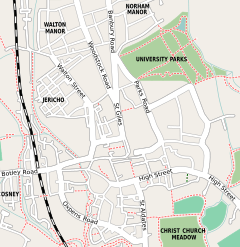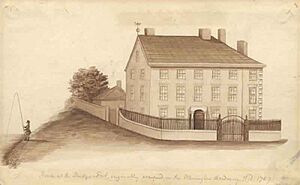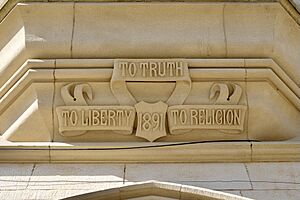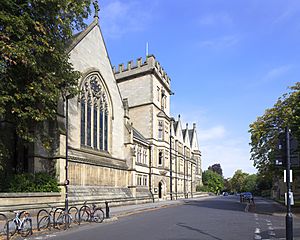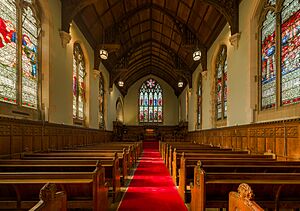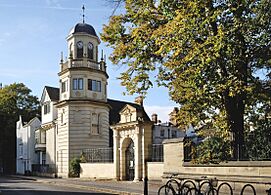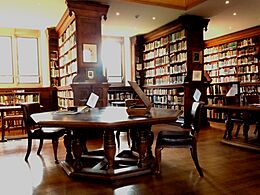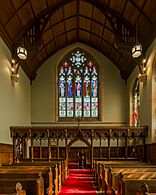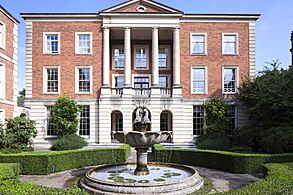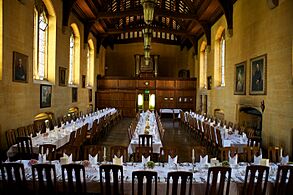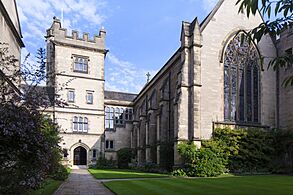Harris Manchester College, Oxford facts for kids
Quick facts for kids Harris Manchester College |
||||||||||||||||
|---|---|---|---|---|---|---|---|---|---|---|---|---|---|---|---|---|
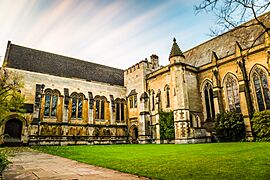
Harris Manchester College Arlosh Quad
|
||||||||||||||||

Blazon: Gules two torches inflamed in saltire proper, on a chief argent, between two roses of the field barbed and seeded, an open book also proper.
|
||||||||||||||||
|
|
||||||||||||||||
| University | University of Oxford | |||||||||||||||
| Location | Mansfield Road (map) | |||||||||||||||
| Coordinates | 51°45′21″N 1°15′07″W / 51.755758°N 1.252044°W | |||||||||||||||
| Full name | Manchester Academy and Harris College | |||||||||||||||
| Latin name | Collegium de Harris et Manchester | |||||||||||||||
| Abbreviation | HMC | |||||||||||||||
| Motto | Veritas Libertas Pietas (Latin) | |||||||||||||||
| Motto in English | Truth, Freedom, Piety | |||||||||||||||
| Established | 1786 | |||||||||||||||
| Named after | Philip Harris, Baron Harris of Peckham | |||||||||||||||
| Previous names | Warrington Academy, Manchester Academy and Manchester College | |||||||||||||||
| Architect | Thomas Worthington | |||||||||||||||
| Sister college | Homerton College, Cambridge | |||||||||||||||
| Principal | Professor Jane Shaw | |||||||||||||||
| Undergraduates | 113 (2020) | |||||||||||||||
| Postgraduates | 178 (2020) | |||||||||||||||
| Senior tutor | Professor Lesley Smith | |||||||||||||||
| Map | ||||||||||||||||
Harris Manchester College (HMC) is one of the colleges that make up the famous University of Oxford in the United Kingdom. It started in 1757 in a town called Warrington. Back then, it was a college for students who followed a religion called Unitarianism.
The college moved to Oxford in 1893. In 1996, it became a full college of the university. It got its current name to honor its old name, Manchester Academy, and a generous gift from Lord Harris of Peckham.
What makes Harris Manchester College special is that it only accepts students who are 21 years old or older. This includes both students working on their first degree (undergraduates) and those studying for advanced degrees (postgraduates). With about 100 undergraduates and 150 postgraduates, it is the smallest college for undergraduates at either Oxford or Cambridge universities.
Contents
History
How the College Started
The college began as the Warrington Academy in 1757. Famous teachers like Joseph Priestley, who discovered oxygen, taught there. In 1786, it was restarted as the Manchester Academy in Manchester.
Originally, the college was run by English Presbyterians. It was one of several "dissenting academies." These schools offered higher education to religious nonconformists. At that time, the only universities in England, Oxford and Cambridge, only allowed students who were part of the Anglican Church.
The college taught new ideas in religion and modern subjects. These included science, modern languages, and history. Its most famous professor was John Dalton, who developed the idea of atomic theory.
Moving Around
The college moved five times before settling in Oxford. It was in Manchester from 1786 to 1803. Then it moved to York until 1840. In York, a Unitarian minister named Charles Wellbeloved was very important. A room in the college is now named after him.
Wellbeloved wanted students to think for themselves. He did not want the school to be called "Unitarian." He wrote in 1809 that he would teach students how to study the Bible. He wanted them to find the truth for themselves.
During Wellbeloved's time, 235 students studied at the college. Many became religious leaders, while others became scholars or business people. Most of them were Unitarian.
In 1840, the college moved back to Manchester. It stayed there until 1853. In 1840, the college also started working with the University of London. This meant its students could get degrees from London. From 1853 to 1889, the college was in London. Finally, it moved to Oxford, opening its new buildings in 1893.
Helping Society Change
In its early years, the college supported important social changes. These included ending slavery in 1778. It also supported the repeal of laws that limited the rights of non-Anglicans.
In the 1920s and 1930s, the college offered courses for the Workers' Educational Association. This group helped working-class people get an education.
Women were allowed to attend some lectures at the college starting in 1876. In 1877, the college created theology exams that both women and men could take. In 1901, Gertrude von Petzold became the first woman to be a qualified minister in England. This was possible because Manchester College was linked to the University of London. London was the first UK university to give degrees to women in 1878. Oxford University did not formally accept female students until 1920.
World War II Efforts
Manchester College played a big part in planning the D-Day landings on June 6, 1944. The British government took over most of the college buildings in 1941. They used them for Naval Intelligence and the Inter-Services Topographic Department (ISTD).
The ISTD's job was to gather information about land features. This was important for when the Allies would return to Europe. The college's Arlosh Hall became the main center for these operations. Temporary huts and tents were even set up in the college's courtyards. The university's School of Geography provided many maps. These maps were very important for the success of the D-Day invasion.
Today's College
Manchester College became a permanent private hall of Oxford University in 1990. Then, in 1996, it became a full college. At that time, it changed its name to Harris Manchester College. This was to recognize a gift from Philip Harris, Baron Harris of Peckham.
Today, the college still only accepts students who are 21 years old or older. This applies to both undergraduate and graduate studies. The college aims to continue its open-minded and pioneering spirit. By focusing on mature students, it helps provide higher education to those who might not have had the chance before.
Buildings
The main courtyard was designed by architect Thomas Worthington. It was built between 1889 and 1893. This area holds the Tate Library and the chapel. The Arlosh Hall, designed by Percy Worthington, was added in 1913. The college also has newer buildings to the west of the main courtyard.
In 2013–2014, the Siew-Sngiem Clock Tower and Sukum Navapan Gate were added. The clock tower has a special message: "It is later than you think, but it is never too late." This refers to the college's role in educating older students.
In 2018, a new building called Maevadi Hall was finished. It has a conference room, student rooms, and a social area for students.
The Chapel
The college chapel was opened in 1893. It is known for its beautiful stained-glass windows. These were made by famous artists Sir Edward Burne-Jones and William Morris. The chapel also has detailed wood carvings and an organ.
The stained-glass windows on the north wall are especially notable. They were put in in 1896 and show the Six Days of Creation. These were given by James and Isabella Arlosh to remember their son.
The Tate Library
Even though Harris Manchester is one of Oxford University's smallest colleges, it has a very large library. It has the sixth largest college library and a great number of books for each student. The library holds books and old papers dating back to the 1400s. It is famous for its very old books and its collection about Protestant Dissenters.
The Tate Library was built by Sir Henry Tate. He also helped create London's Tate Gallery. The library was made bigger in 2011 with a new gallery. This new part was designed to match the old Victorian Gothic style. The library has many books on subjects like English Literature, Philosophy, Theology, Politics, Economics, Law, History, and Medicine. It also has the Carpenter Library of World Religions.
Harris Manchester College is very close to the Bodleian Library. This is the main research library of Oxford University. It is also near other university libraries for different subjects.
Student Life
Even with a small number of students, the college offers many courses. Many lessons (tutorials) happen within the college. For some special subjects, students might go to tutors in other colleges.
Students are usually expected to eat dinner in the Arlosh Hall. There are formal dinners twice a week, on Mondays and Wednesdays. For these, students wear jackets, ties, and gowns.
Sports
The college does not have its own sports ground. However, it regularly enters women's and men's teams into university leagues. Students also often join teams from other colleges. The college has a special boat called a punt, named The Royle Yacht. It also has a croquet lawn.
In recent years, the college's ice hockey team has done well. They once won second place in a university tournament. The basketball team won third place the year before. There is also an active pool team and a busy squash club.
Harris Manchester also works with Wadham College nearby. Students interested in rowing can join the Wadham College Boat Club.
Junior Common Room (JCR) Bar
Harris Manchester has one of only three student-run college bars in Oxford. The other two are at Balliol College and St Cross College. The common room is decorated with wallpaper by William Morris.
Gallery
Notable People
- Notable people associated with Harris Manchester College
-
Joseph Priestley, (Warrington Academy) Credited with discovery of oxygen
-
Thomas Malthus, (Warrington Academy), British political economist
-
Íngrid Betancourt (Harris Manchester College), Colombian senator and anti-corruption activist
Principals
Since 2018, the principal of the college has been the historian, Professor Jane Shaw.
Famous People Connected to the College
Many important people have been connected to Harris Manchester College over the years. These include:
- Joseph Priestley, who discovered oxygen.
- John Dalton, who developed the atomic theory.
- Gertrude von Petzold, the first woman minister in England.
- Íngrid Betancourt, a Colombian politician.
- Roger Bannister, the first person to run a mile in under four minutes.
- Janina Ramirez, an art historian and TV presenter.
See also
 In Spanish: Harris Manchester College para niños
In Spanish: Harris Manchester College para niños


